In a Singapore caught up in the frenzy of celebrating the abandonment of the past, being given an opportunity to celebrate a piece of our pre-independent history, the Singapore Botanic Gardens (SBG), is a welcome distraction. The 74 hectare green space, recently inscribed as the country’s first UNESCO World Heritage Site, is one that connects the generations as a community space, a constant in a Singapore in which change seems to be the only other constant, for which alone it deserves to be celebrated.

The bandstand and its iconic gazebo, one of several conserved sites within the SBG.
The inscription into the UNESCO list gives us a lot more reason to celebrate. The Gardens has long played a role not just as a community space, but as a centre for botanical research, it has made immense contributions even to Singapore’s (and Malaya’s) early economy. The rise of rubber as an economic crop and the spread of rubber plantations, once dominant across our island’s rural areas, across much of Malaya, owes much to the work carried out in the SBG and Henry Ridley, the SBG’s first scientific director. The rural landscape while now conquered by the sea of concrete, owes much of its green colouring, a product of the efforts to transform Singapore into a Garden City, also to the SBG.

Henry Ridley and his work on rubber is remembered in the SBG Heritage Centre.
Green is a colour that paints the Botanics is beautifully. Home to numerous heritage trees, it also is a showcase of more than 10,000 tropical plants. Offers an escape many seek from the insanity and clutter of the urban world, its wide open lawns provide our young with the space necessary to learn that life is not just about virtual play. The same lawns have given great service to society. One, was to provide the space for the first Aneka Ragam Ra’ayat or People’s Variety Show that drew a crowd of 22,000. The shows were an initiative to help unify Singaporeans in the early days of full self-government and started in 1959.
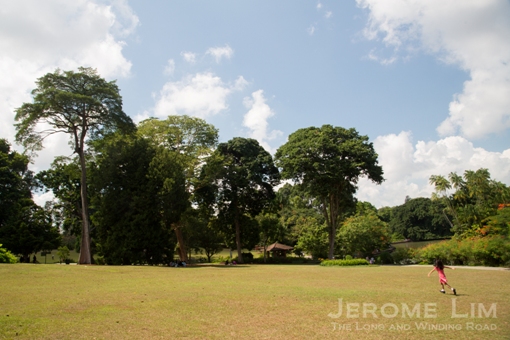
Space to run free.

One of several heritage trees.
My first acquaintance with the Gardens came about in my earliest of years. On the evidence of my childhood albums and the long lasting fascination I had with sundials and black swans, many of my early interactions with the SBG would have taken place in the Tanglin Core, the oldest part of the gardens. This part of the Gardens is where many of its heritage sites are to be found, including Singapore’s the first ornamental body of water, Swan Lake, which was completed in 1866. Several of the Gardens’ icons can be found close to the lake such as the famous tembusu tree that has found its way to the back of our five-dollar note, the Bandstand – a popular spot for wedding photographs to be taken at, and Swan Lake Gazebo. The cast iron gazebo harks back to a forgotten age and is one that graced the Royal Navy’s Commander-in-Chief’s one time residence (at old Admiralty House on Grange Road, which was demolished in the 1960s to allow the 2nd Raffles Institution campus to be built).

When I first met the acquaintance of the sundial.

The iconic tembusu tree attracts large crowds.
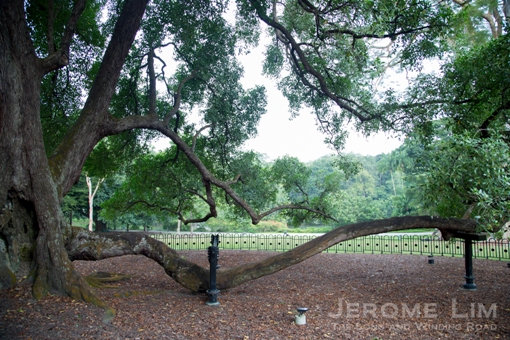
Dynamic supports developed by ST Kinetics now support the outstretched branch of the tembusu on which many previously posed for photographs.
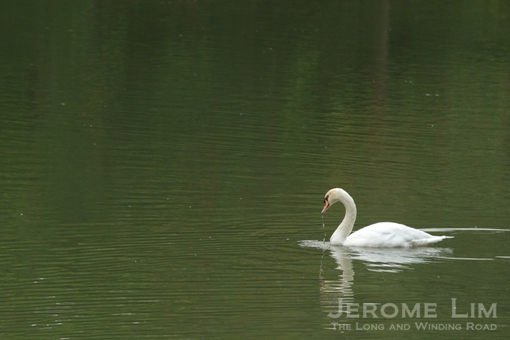
Swan Lake, Singapore’s first ornamental lake.

A bamboo clump – one of the tiniest species of bats, the bamboo bat, can be found roosting in the Gardens.

A wider view of Swan Lake.

The Bandstand is a popular spot for wedding photography.

The cast iron Victorian Swan Lake Gazebo, previously of Old Admiralty House at Grange Road.
Also within the Tanglin Core, is an old building that offers cool relief, especially on a hot day, Holttum Hall. Built in 1920, the two storey bungalow, one of four conserved bungalows found on the site (more information on which can be found at the Urban Redevelopment Authorty (URA) Conservation Portal), now houses the SBG Heritage Museum. The hall is close to the Botany Centre – one of the visitor gateways into the Gardens and holds a wealth of information in its interactive and multimedia exhibits on the work that went on in the gardens and its role in the proliferation of rubber as a crop.

The SBG Heritage Centre in Holttum Hall.

An exhibit showing the herringbone pattern developed by Ridley to tap rubber.
One of the things I was surprised to learn about the SBG, was that what is thought to be the oldest and largest orchid plant in the world, can be found on its grounds. The plant, a clump of tiger orchid, wears a rather undignified appearance. Measuring some 5 metres in diameter, it is thought to be the one planted in 1861 by Lawrence Niven, the SBG’s first superintendent who is credited with its development, just two years after the Gardens was established.

The oldest orchid?

Flowers belonging to the world’s oldest orchid plant.
Another interesting site is at Plant House. Here, arrows can be found marked into several of the red bricks of its steps, the significance of which only came to light in 1995, when a group of former prisoners of war visiting from Australia told of how the arrows got on the bricks. Apparently the arrows, a symbol then commonly used to mark government property, were marked by the POWs involved, as an act of defiance. More on this story (and also of Lawrence Niven) can be found here.

The steps of plant house.

A close-up of the bricks used to make the steps – with arrows seen on some of them.
Adjoining the Tanglin Core and to its north is the Central Core. Here, laid out over the highest point of the grounds, one finds the National Orchid Garden. Opened by Singapore’s first prime minister Mr Lee Kuan Yew in 1995, the National Orchid Garden celebrates its 20th anniversary on 20 October. In it, the visitor will find over 1000 species and 2000 hybrids of orchids on display, making it an especially colourful site. Nestled in the midst all that colour is is another of the SBG’s four conserved bungalows, Burkill Hall. A former plantation owner’s bungalow built in 1886, it now is rented out as an event venue. The National Orchid Garden is also where the most vandalised tree in Botanics can be found. As part of the celebration of its 20th anniversary, SG50 and SBG’s UNESCO World Heritage Site inscription, admission into the National Orchid Garden will be free until the 31st of August for all resident in Singapore (this includes Singapore citizens, permanent residents and others residing in Singapore such as EP, Work Permit and Dependent Pass holders).

Burkill Hall.

The most vandalised tree.

A close-up of it.

The National Orchid Garden is a riot of colour with some 1000 species of orchids on display.

SBG Director Dr Nigel Taylor with National Orchid Garden nursery manager David Lim.

The National Orchid Garden seen through the porch of Burkill Hall.
It seems these days that no attraction in Singapore is compelete without something to tempt the palate. The SBG these days certainly isn’t short of this with its range of gastronomical delights found in the abundance of the food and beverage outlets now found in the Gardens. One of these outlets can be found close to the National Orchid Garden, set in the tranquility of the Ginger Garden. This, the ginger themed restaurant Halia at Singapore Botanic Gardens, seems to have been caught up in the celebratory mood and has come up with a special SG50 menu of orchid inspired desserts and beverages. Orchid tea blends from the SBG Gardens Shop feature in the beverages, two cocktails, Yam Seng and 1965, and a mocktail, Singapore Jubilee.

A ginger plant inspired mural at the Ginger Garden.

Halia at SBG.
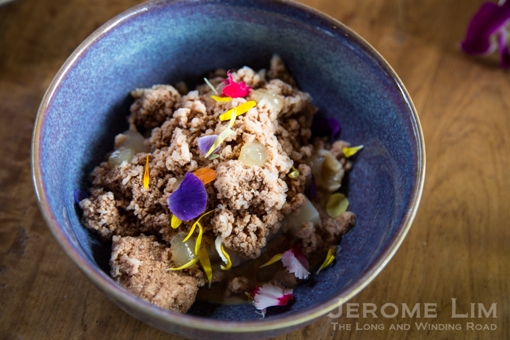
Ginger and Gold at Halia.
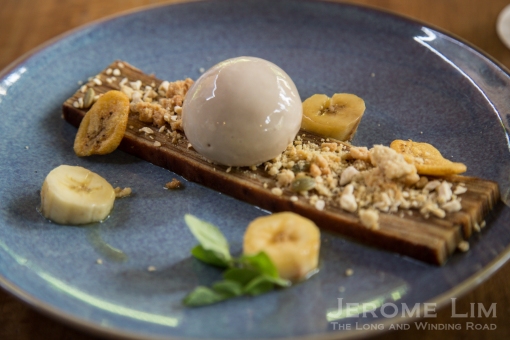
White and Lapis.

SG50 Cocktails at Halia.
Nassim Gate Visitor Centre, which lies northeast of the Ginger Garden, are where another two F&B outlets can be found. One, the Casa Verde, which touts itself as a “casual trattoria”, offers casual dining. On its menu over the National Day period (from 3rd to 17th August 2015, served from 12pm to 2.45pm but not on weekends and public holidays), several local favourites curated by its chef Danny Tan, can be selected. The dishes, Singapore Laksa, Mee Siam, Mee Rebus, and Char Kway Teow, are priced reasonably and have a soft drink thrown in. Diners at the tratorria can also look forward to its National Day celebration when its fresh oven baked pizzas come with a 50% discount on 9 August from 11.30 am to 5.45 pm. Casa Verde will also run a Kids Pizza Making workshop on 7 August at 2 pm as part of the celebration.

Offerings at Casa Verde for the National Day period.
A stone’s throw away from the “green house”, we find Corner House, set in a beautifully restored conserved two-storey bungalow, E J H Corner House. The fine-dining restaurant offers the Gastro-Botanica creations of Chef Jason Tan and to mark the country’s 5oth birthday and the restaurant’s first anniversary, Chef Tan is presenting his Celebratory Discovery Menu (available until 16 August 2015 – for dinner only). The menu takes diners on an eight course journey that traces the various stages in the development of Singapore’s culinary scene. Each course reinterprets the chef’s favourite dishes along that journey, which I must say is pretty impressively on the basis of two items on the menu I got to have a taste of, one of which the Remembering Oyster Omelette. That does have me recall the flavour of the real hawker dish, and one with which I found myself transported back at first bite to that car park opposite Cold Storage that became known as Gluttons’ Square.

Corner House – The Verandah.

The Reading Room.

The Claret Corner.

The Claret Corner.

Remembering Oyster Omelette.

Chef Jason Tan.

My Corner of the World – Durian Bread and Butter Pudding.

Delightful salted egg macarons served after each meal.
For those for whom only the real hawker fare will complete an outing to Botanics, one can, rather surprisingly, find a food court on the grounds of the SBG, Food Canopy. While it may not offer the same fare as the food centre at Taman Serasi many from my generation miss, the food court, tucked away in a quiet corner of the Bukit Timah Core (close to the MOE Co-Curricular Activities Branch, CCAB), offers a choice of hawker fare with its seven stalls. One of these, is the Di Wei Teo Chew Restaurant, which offers Teochew classics such as cold crab, chye poh kway teow, pan-fried pomfret, yam rings and Teochew yam strips.

Cold crab and chye poh kway teow.

For the those with a sweet tooth, Teochew yam strips.
Besides the food on offer, visitors to the SBG over the so-named Jubilee Weekend (7 to 9 August 2015), will find a host of activities to celebrate independent Singapore’s 5oth anniversary, including a carnival at the Bandstand and Orchid Plaza with activities and food offerings that include some that bring back the good old days. There will also be a reenactment of the People’s Variety Show, movie screenings and concerts to look forward to. The SBG’s Shaw Foundation Symphony Stage will, on the evening of 9 August, provide an alternative site to catch a live-screening of the National Day Parade from. More information on the activities over the weekend can be found at the NParks SBG Jubilee Weekend page.

Offerings at the Gardens Shop – no visit is complete without dropping by.




































































